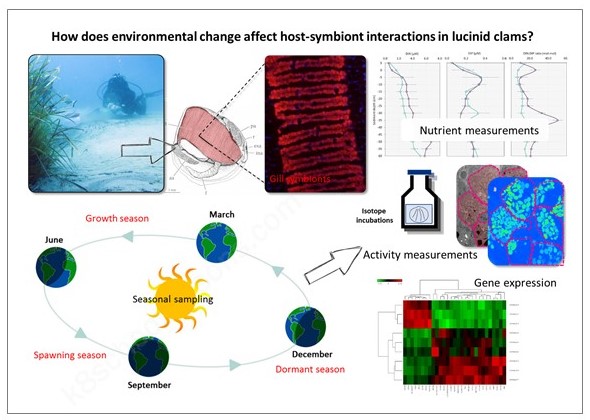Host-microbe interactions in marine lucinid clams
The symbiosis between lucinid clams and their chemosynthetic endosymbionts is ideal for understanding effects of seasonality; the symbionts rely on energy sources such as hydrogen sulfide from the environment, thus symbiont activity is intimately linked to environmental conditions. Lucinids experience substantial shifts in environmental parameters throughout the year. Nutritional exchange is the fundamental basis for maintaining this symbiosis, but like most nutritional symbioses, the mechanisms of nutrient transfer and the compounds exchanged are unknown. Preliminary data from stable isotope measurements suggests substantial differences in symbiont contribution to host nutrition in two different seasons (Cardini, Petersen et al., in preparation). It was also suggested that symbiont biomass is ‘mobilized’ to provide energy for host gametogenesis, directly linking symbiont activity and host reproduction.
Project 1: The seasonal cycle of symbiotic life
Aims: Test the hypothesis that seasonal changes regulate the nature and strength of the potential benefits symbionts provide their hosts by A) characterizing geochemical parameters in sediment surrounding lucinid clams, B) quantifying bulk holobiont activity in at least two different seasons, and C) Investigating symbiont abundance and activity and holobiont gene expression across the spawning season.
Approach/Methods: Sampling in at least two seasons, symbiont carbon and nitrogen fixation quantification with stable isotope incubations, whole animal incubation in deuterium-labelled water to assess holobiont metabolic activity, quantification of symbiont abundance with fluorescence in situ hybridization, dual RNAseq of holobionts before and after spawning.
Student: Marta Sudo
Faculty: Petersen (PI), Bright, Berry
Funding: FWF doc.fund project MAINTAIN
Project 2: Molecular host-microbe interactions in a marine invertebrate symbiosis
Aims: Test the hypothesis that carbon fixed by the symbionts is rapidly transferred to the host, at scales ranging from cells to organs to the entire animal body by A) quantifying symbiont carbon fixation at the single-cell level in at least two different seasons, B) determine which compounds are transferred from symbiont to host, C) image nutrient transfer at the single-cell level.
Approach/Methods: Sampling at least two seasons, incubations with H13CO3-, Raman microspectroscopy to quantify fixation rates, nanoSIMS, metabolomics and compound-specific stable isotope analyses, mass spectrometry imaging of metabolites.
Student: Cristina Alcaraz
Faculty: Petersen (PI), Bright, Wagner, Köllensperger, Rattei
Funding: ERC
Relevance (of project 1 & 2): The projects will reveal fundamental principles of how homeostasis and coordination of host and symbiont activity are achieved under changing environmental conditions, and during host reproduction. We will investigate whether gill symbionts can directly affect host reproduction.

Selected publications:
Taylor, J. D. & Glover, E. A. Functional anatomy, chemosymbiosis and evolution of the Lucinidae. Geological Society, London, Special Publications 177, 207–225 (2000).
Bosc, E., Bricaud, A. & Antoine, D. Seasonal and interannual variability in algal biomass and primary production in the Mediterranean Sea, as derived from 4 years of SeaWiFS observations: Global Biogeochem. Cycles 18, (2004).
Dedieu, K., Rabouille, C., Gilbert, F., Soetaert, K., Metzger, E., Simonucci, C., Jézéquel, D., Prévot, F., Anschutz, P., Hulth, S., Ogier, S. & Mesnage, V. Coupling of carbon, nitrogen and oxygen cycles in sediments from a Mediterranean lagoon: a seasonal perspective. Mar. Ecol. Prog. Ser. 346, 45–59 (2007).
Johnson, M. A. & Fernandez, C. Bacterial symbiosis in Loripes lucinalis (Mollusca: Bivalvia) with comments on reproductive strategy. J. Mar. Biol. Assoc. U. K. 81, 251–257 (2001).



